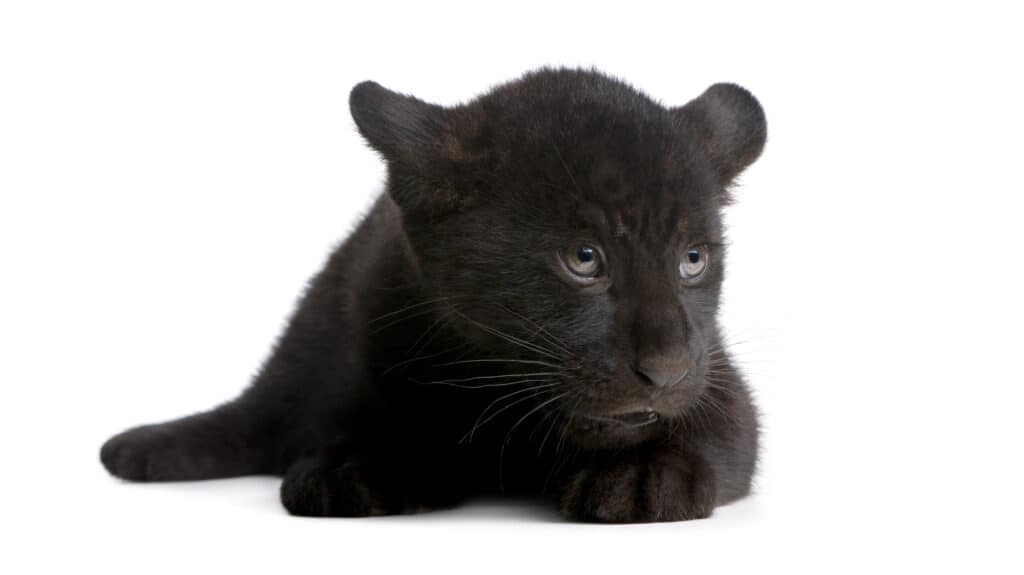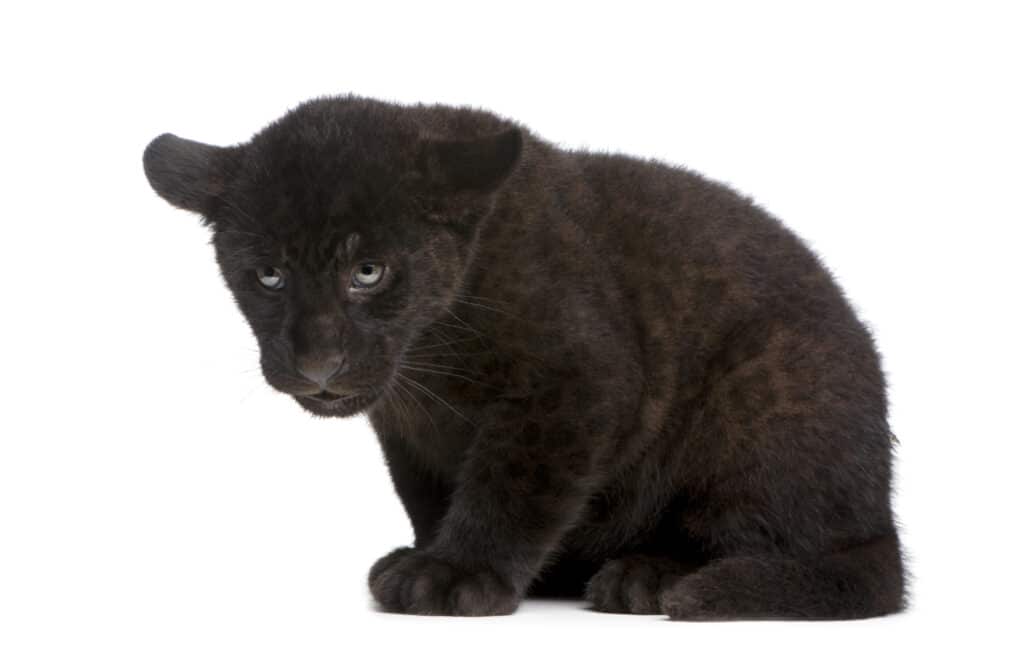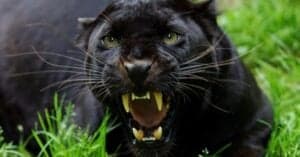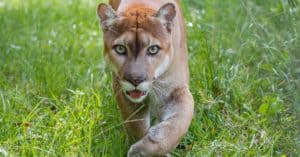Baby animals are cute, and there’s no doubt about that. Baby panthers are no exception! Though most people associate panthers with spooky stealth and deadly attacks, these sleek carnivores begin life as fluffy balls of fur. In fact, if you didn’t know better, you might think they were nothing more than particularly adorable house cats. Don’t be fooled: panther cubs grow up to be some of the most fearsome predators in the animal kingdom. Read on to discover 10 fascinating facts about baby panthers!
1. Panther Babies Are Black Due to an Excess of Pigment

Panther cubs are really
leopard
or jaguar cubs, just with unusual black fur.
©Eric Isselee/Shutterstock.com
Panthers are not a separate species; rather, they are a melanistic color variant of big cat species in the Panthera genus. This means that baby panthers have a high concentration of melanin, a pigment responsible for dark coloration in animals. Panthers may be black leopards (Panthera pardus) or black jaguars (Panthera onca). So panther cubs are really leopard or jaguar cubs, just with unusual black fur. The distinctive leopard and jaguar rosettes (spots) may still be present in panther cubs, but they are almost impossible to see against their black fur.
2. Some Baby Panthers Are Born To Spotted Parents
Because panthers aren’t a separate species, panther cubs are often born to parents who don’t look like them. They gain their dark coloration from their parents’ genes, which are either recessive or dominant. In leopards, the dark mutation is the result of recessive genes. Therefore, spotted parents who both have the recessive gene may produce black offspring. In jaguars, however, the mutation is the result of dominant genes. A black jaguar can give birth to both black and spotted cubs. A spotted jaguar, on the other hand, can only produce spotted cubs.
3. Baby Panthers Are Born Blind
That’s right; baby panthers can’t see a thing at birth! Although they are apex predators, panther cubs are born completely helpless, with their eyes closed. This blindness lasts for 10-14 days. After this, the cubs’ eyes open. Before they gain their sight, the cubs rely on their keen sense of smell to locate their mother. Ironically, once they reach adulthood, panthers have incredibly sharp eyesight.
4. Newborn Panthers Don’t Eat Meat

Newborn panthers drink milk from their mother until they reach three to four months of age.
©Eric Isselee/Shutterstock.com
Panthers are obligate carnivores, which means they can’t get the nutrition they need from plant matter. To survive, they must consume animal flesh. However, baby panthers haven’t developed enough to live on meat. These future ferocious carnivores drink milk from their mother like any other mammal until they reach three to four months of age. Then their mother begins introducing scraps of meat to their diet. Eventually, panther cubs learn how to hunt for themselves and become the apex predators they were born to be.
5. Young Panther Cubs Don’t Hunt With Their Mother
Until the age of four months or so, baby panthers are too small and inexperienced to hunt with their mother. This means she has to leave them behind in the den while she goes out in search of food, sometimes for days. During this time, they are incredibly vulnerable to attacks from predators like lions, hyenas, and large birds of prey.
6. Baby Panthers Practice Hunting
Despite having all the genes necessary to grow into fierce predators, baby panthers still have to practice their hunting techniques before they can join their mothers on the hunt. Without preternatural stealth and patience, apex predators face a short, hungry future. Panther cubs must learn how to stalk, wait for opportunities, and pounce when the time is right.
They learn this by “hunting” inanimate objects like leaves, twigs, and rocks. They also engage in vigorous horseplay with their siblings. When their mother deems them ready to accompany her on a real hunt, she has them practice with small animals like rabbits. By the age of 10-12 months, most young panthers can bring down mid-sized prey like warthogs.
7. Baby Panthers Live In Nurseries
You might think a nursery is only for human babies, but you’d be wrong! Panther mothers keep their babies in nurseries, a special type of den that protects them from predation and other threats. Lucky observers may catch a glimpse of a panther, leopard, or jaguar carrying their cubs from nursery to nursery, changing location every two to three days to throw off predators.
8. Baby Panthers’ Eyes Change Color

Panthers develop their signature golden or emerald green eyes over time.
©Eric Isselee/Shutterstock.com
Baby panthers often start life like many other felines: with astonishingly blue eyes. However, these adorable eyes aren’t there to stay. Over time, panthers develop their signature golden or emerald green eyes. As nocturnal creatures, they typically hunt at night, an apt choice for dark-furred predators. Their eyes are well-suited to the darkness, though they also rely on their incomparable sense of smell to locate prey.
9. Young Panthers Remain With Their Mothers for up to Two Years
Despite being solitary creatures by nature, baby panthers stay with their mothers for as long as one and a half to two years after birth. During this time, they sharpen their survival techniques and prepare to seek out mates.
Like other leopards and jaguars, panthers confine themselves to ranges, areas they mark out as their own territories. Young panthers eventually leave their mothers to establish their own ranges. During this transition time, they may move in and out of their mother’s range as they grow accustomed to life on their own.
Panthers are extremely territorial animals, especially males. Male panthers jealously guard their ranges and the ranges of nearby females with which they overlap. They do this to secure exclusive mating rights and propagate their own genes. Other than to mate and raise young, panthers rarely interact with each other. Infanticide occasionally occurs when panthers, leopards, or jaguars end up in the same area as other adult members of their species in the presence of young, most likely due to the inherent competition for resources.
10. Baby Panthers Enjoy Swimming
Baby panthers are able to swim and, in some cases, even enjoy it. This comes as no surprise, given that both leopards and jaguars are capable swimmers. Being able to navigate the water is a useful adaptation in the tropical rainforests, woodlands, and swamplands panthers call home.
Though panthers start out as helpless cubs, they grow into some of the most ferocious apex predators on the planet. Married to their shadowy appearance, this deadly temperament inspires fear and awe in humans around the globe.
Up Next:
- 10 Incredible Panther Facts
- Jaguar vs. Panther – The 7 Key Differences
- Leopard vs. Jaguar – The 7 Key Differences
The photo featured at the top of this post is © Eric Isselee/Shutterstock.com
Thank you for reading! Have some feedback for us? Contact the AZ Animals editorial team.







